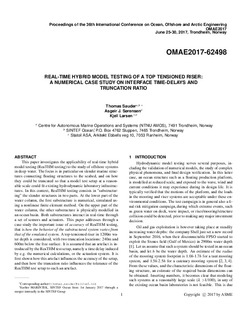Real-Time Hybrid Model Testing of a Top Tensioned Riser: a Numerical Case Study on Interface Time-Delays and Truncation Ratio
Chapter
Accepted version
Permanent lenke
http://hdl.handle.net/11250/2459498Utgivelsesdato
2017Metadata
Vis full innførselSamlinger
- Publikasjoner fra CRIStin - SINTEF Ocean [1387]
- SINTEF Ocean [1461]
Originalversjon
ASME 2017 36th International Conference on Ocean, Offshore and Arctic Engineering, Volume 2: Prof. Carl Martin Larsen and Dr. Owen Oakley Honoring Symposia on CFD and VIV 10.1115/OMAE2017-62498Sammendrag
This paper investigates the applicability of real-time hybrid model testing (ReaTHM testing) to the study of offshore systems in deep water. The focus is in particular on slender marine structures connecting floating structures to the seabed, and on how they could be truncated so that a model test setup at a reasonable scale could fit existing hydrodynamic laboratory infrastructures. In this context, ReaTHM testing consists in “substructuring” the slender structures in two parts. At the lower part of the water column, the first substructure is numerical, simulated using a nonlinear finite element method. On the upper part of the water column, the other substructure is physically modelled in an ocean basin. Both substructures interact in real-time through a set of sensors and actuators. This paper addresses through a case study the important issue of accuracy of ReaTHM testing, that is how the behavior of the substructured system varies from that of the emulated system. A top-tensioned riser in 1200m water depth is considered, with two truncation locations: 240m and 600m below the free surface. It is assumed that an artefact is introduced by the ReaTHM test setup, namely a time delay induced by e.g. the numerical calculations, or the actuation system. It is first shown how this artefact influences the accuracy of the setup, and then how the truncation ratio influences the tolerance of the ReaTHM test setup to such an artefact.

